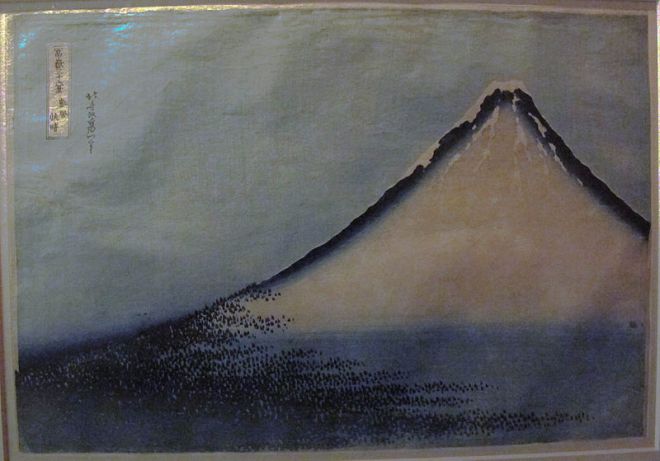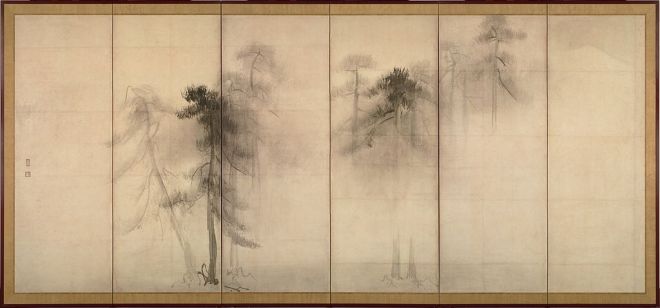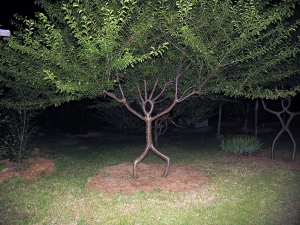
The point at which emptiness is emptied to become true emptiness is the point at which each and every thing becomes manifest in possession of its own suchness. (Religion and Nothingness, 106)
In order to approach the fact that fire is, reason invariably goes the route of asking what fire is. It approaches actual being by way of essential being …This standpoint does not enter directly and immediately to the point at which something is. It does not put one directly in touch with the home-ground of a thing, with the thing itself.(RN, 114)
From the pine tree, learn of the pine tree. And from the bamboo, of the bamboo. (Haiku poet Basho)
Circuminsessional interpretation: That a thing is itself means that all other things, while continuing to be themselves, are in the home-ground of that thing; that precisely when a thing is on its own home-ground everything else is there too; that the roots of every other thing spread across into its home-ground.” (RN,149)
The standpoint of reason – sub-stance and sub-ject – and the paradox of representation

“Throughout the history of Western thought, from the days of ancient Greece right up to the present, being or existence has, by and large, been thought of in terms of either the category of “substance” or that of “subject.” Whether animate or inanimate, man or even God, insofar as an entity is considered to exist in itself, to be on its own ground, it has been conceived of as substance. The concept of substance points to that which makes a thing to be what it is and makes it preserve its self-identity in spite of the incessant changes that occur in its various “accidental” properties.” (110)
The word “substance,” comes from the Latin substantia and substare, “to stand firm, be under, or present,” from sub, under, and stare, to stand. It is clear that the key prefix here is “sub” – sub-stance, sub-ject. Some sort of reality that is more real than what manifests to our senses is assumed to support the world we see. Aristotle called it the sub-stratum underlying change. Heidegger has shown how substantia was used as a translation for ousia, which was a form of enai, “to be.” In other words, substance came to mean being, what makes a thing to be what it is, beneath the various changes captured at the sensory level. “Suppose, for example, that this “thing” were a human being. Then substance would denote the “beingness” of such a reality in its mode of “being as a man.” It is generally held that substance is imperceptible to the senses, that as the selfness of a thing lying behind various sensory appearances, it can only be grasped through thinking. (119)
This unchanging reality taken to be “being” was regarded as a transcendental order, received as it were, from above, and which humans had to “discover.” Plato called it the realm of Ideas, where all the beings we saw pre-existed as Forms of which the beings we see are copies. It seems that Plato saw the Ideas as, as it were, wired into our minds – since we were made by the same transcendental order (God) as the rest of creation. Aristotle added that the way we discovered the Ideas was by watching the natural world, and inducting the transcendental Ideas from their manifestations in reality. As we saw when looking into Nishida’s analysis of Aristotle, “to know a thing is to name it, and to name it is to attach one or usually more universal predicates to it.” (Carter, The Nothingness Beyond God, 25-26)
Even though things fully grasped as objects by a subject only came to the fore with Descartes’ philosophy of consciousness, Greek philosophy already apprehended things as objects. This is why Nishida could speak of “object logic.” Nishitani states, likewise, that “Being is looked upon as substance because, from the very outset, beings are looked upon as objects; and thus also, conversely, because beings set before the subject representationally are viewed from the subject’s point of view. The paradox of representation [already] comes into play here. It is the same with “life” or “soul” when these are conceived of in terms of substance. (110).

With Descartes, the notion that the rational order of the world is still received by humans as a given, but the focus switches from an emphasis on its transcendental, divine, aspect to the urgency of deciphering that order. It could be seen as one more step in the direction already taken by Aristotle. The motive, for Descartes, was to be able to expand our knowledge of reality so as to get a better control of our lives. Hence the new focus on the subject, and Descartes’s assertion that “I think, therefore I am,” i.e., I am “one who thinks,” so I am able to investigate the rational order, now, more or less equated with a mathematical order. In other words, there is legitimacy in embarking on an investigation of reality. At the same time, as the goal is to achieve an “objective” view of reality, the subject is as far as possible divorced from its subjective particularities (affective, body-based, elements active in ordinary life) that could distort its thought. But, Nishitani remarks, “to say of something merely that it lies outside of subjectivity is still an act of subjectivity. An object is nothing other than something that has been represented as an object, and even the very idea of something independent of representation can only come about as a representation. This is the paradox essential to representation.” (108)
Nishitani concludes: “Both materialism and idealism lose sight of the basic field where the reality of things and praxis initially come about; they lose sight of the sort of field where things become manifest in their suchness, where every action, no matter how slight, emerges into being from its point of origin.” (121) In other words, the Western standpoint of being, whether in its early formulation as substance, or in its modern formulation as objects represented by subjects, has no access to the things as both are really dealing with representations.
Kant’s revolution – reason as something that thought ‘thinks into” objects – opens the way to existential inquiry
Kant, however, had opened a new path. Once the circumstances lying behind the formation of the concept of substance are brought to light, it is natural to propose, as Kant did, the basic position that all objects are representations, and therefore “appearances”; and to interpret substance as one of the a priori concepts of pure reason, as something that thought ‘thinks into’ (hineindenkt) objects. (111) Kant’s revolutionary contribution was that the way we see reality is reality as perceived through the particular structures of our minds, which, by then, were no longer taken to be the product of a divine wiring, but the mere products of our physical make-up. “No doubt Kant marks a milestone in the awareness of such a subject. Since his time, the process of awakening to subjectivity has progressed rapidly, arriving at the notion of ecstatic existence within nihility, that is, at the notion of subjectivity in Existenz. The same subject now comes to exist within nihility “essentially,” that is, in such as way as to disclose its very “existence” in nihility.” (111) So Kant opened the way for existential inquiry, and Nishitani sees himself as having brought that existential inquiry to its logical end – an inquiry from the standpoint of ecstatic existence, the standpoint of emptiness – self as no-self – through which the ego-centred standpoint is overcome.
To sum up, in Nishitani’s words, “on the field of reason the selfness of things merely represents the sort of Form in which they appear to us who happen to be thinking about them. The function of thinking, as an activity of reason in us, is to journey beyond the field of sense perception to a field on which things can be made to disclose their selfness. Therein lies the particular significance of thinking. But for that very reason, the “substance” (or the object) grasped on the field of reason cannot but be the mode of being of a thing in its selfness insofar as it appears to us and insofar as it is seen by us. We would be hard put to show that this points straight to the thing itself in its mode of being where it could be said to be on its own home-ground. Such original selfness must lie beyond the reach of reason and be impervious to thought. (119-120)
This “field that goes beyond consciousness and intellect” is the “field of sunyata or emptiness.” (121) “On the field of emptiness … the selfness of a thing cannot be expressed simply in terms of its “being one thing or another.” It is rather disclosed precisely as something that cannot be so expressed. Selfness is laid bare as something that cannot on the whole be expressed in the ordinary language of reason, nor for that matter in any language containing logical form. Should we be forced to put it into words all the same, we can only express it in terms of a paradox, such as: “It is not this thing or that, therefore it is this thing or that.” (124)
“This is not fire, therefore it is fire”

Nishitani takes the well-known formula of the Diamond Sutra as encapsulating this paradox of the selfness of things – what they are for themselves, on their home-ground: “This is not fire, therefore it is fire.” The key point here is that “fire does not burn itself.”
“The burning that takes place when the fire burns firewood points to the selfness of fire, but so does the fact that fire does not burn itself. The two are here one and the same. As something that burns firewood, fire does not burn itself; as something that does not burn itself, it burns firewood. This is the mode of being of fire as fire, the self-identity of fire. Only where it does not burn itself is fire truly on its own home-ground. In other words, we speak not only of the selfness of fire for us, but also of the selfness of fire for itself … That a fire sustains itself while it is in the act of burning means precisely that it does not burn itself. Combustion has its ground in non-combustion. Because of non-combustion, combustion is combustion. The non-self-nature of fire is its home-ground of being.” (116-117)
This insight parallels the Zen saying about mountains and waters, which first appear as solid entities to the ignorant novice, then come to be seen as empty of being by the more mature student, and, upon enlightenment, are found to be mountains and waters again, precisely as phenomena, “lined with emptiness,” since true reality is conceived as the arising of forms out of the formless, a dynamic rather than an order of things. (See “Self-Contradictory Identity” in the Nishida section). “In symbolic representation: A is A; A is not-A; therefore A is A. I see the mountains. I see that there are no mountains. Therefore I see the mountains again, but as transformed. And the transformation is that the mountains both are and are not mountains. That is their reality.” (Robert E Carter, The Nothingness Beyond God, 58). In Nishitani’s terms: “the “what” of a thing is a real “what” only when it is absolutely no “what” at all.” (125)
Ludwig Wittgenstein stated likewise “the mystical is not how the world is, but that it is.” To be sure, for the Eastern mind, the life principle which goes through reality and shape its endless variety of living forms is way more fascinating that the evanescent things which arise along the way. Though, at the same time, the very evanescence of things is also viewed as precious – the celebration of the cherry tree blossoms is a famous example.
We speak here of the field of the selfness of things, the self-identity of things where they appear pro seipsis (for themselves) and not pro nobis (for us). And since this field is absolutely other than the standpoint of everyday life, of science, or of philosophical thinking, the self-identity of a thing on this field – for instance, the fact that this is fire – can be truly expressed in the paradox: “This is not fire, therefore it is fire.” (118)
Nishitani sums up: “A hot thing emerges into being as what it is in itself at a point beyond all categories of substance, quality, quantity and the like – namely on the field of sunyata … It is a … mode of being that has nothing at all to do with our representations or judgments … On its home-ground, a thing … is purely and simply itself, as it is in its selfness and nothing more. (127) Paradox goes some way in elucidating what a thing is on its home-ground, but it certainly fails to really give us a true apprehension of what Nishitani calls “a non-cognitive knowing of the non-objective thing in itself … what we might call a knowing of non-knowing.” (139)

“From the pine tree, learn of the pine tree. And from the bamboo, of the bamboo.”
We need “a completely different concept of existence,” one that the haiku poet Basho hints at in the following verse: “From the pine tree, learn of the pine tree. And from the bamboo, of the bamboo.” (128)
Of course, Nishitani adds, “Basho does not simply mean that we should ‘observe the pine tree carefully’.” Still less does he mean for us to “study the pine tree scientifically.” He means for us to enter into the mode of being where the pine tree is the pine tree itself, and the bamboo is the bamboo itself, and from there to look at the pine tree and the bamboo. He calls on us to betake ourselves to the dimension where things become manifest in their suchness, to attune ourselves to the selfness of the pine tree and the selfness of the bamboo. The Japanese world for “learn” (narau) carries the sense of “taking after” something, of making an effort to stand essentially in the same mode of being as the thing one wishes to learn about. It is on the field of sunyata that this becomes possible. (128)
Attunement is a key word in Daoism. It is the way of divination in the Yijing. It is the way Ding the butcher cuts his ox in the Zhuangzi, so that he never has to buy another knife. It is also the way an adversary is defeated in martial arts. It requires a complete openness, achieved through self-emptying, an intense focus on what one wishes to attune with, and the arising of a sense of feeling-with so that we can enter the mode of being of the thing. The way a mother communicates with a newborn, who cannot even open its eyes, may also give an idea of what is required. “The point at which emptiness is emptied to become true emptiness is the point at which each and every thing becomes manifest in possession of its own suchness.” (106).
It is what is referred to in Dogen’s famous formula in the Genjokoan: “To study the Way is to study the self. To study the self is to forget the self. To forget the self is to be enlightened by all things. To be enlightened by all things is to remove the barriers between one’s self and others.”
It is a new relationship in knowledge whereby “the self fashion(s) itself after things and correspond to them.” To be sure, it seems to me that it is the recovery of a very ancient relationship, which had been displaced by the triumphant march of objective knowledge in science and technology. As, however, we must now journey beyond the standpoint of reason and knowledge as representation to reach the standpoint of emptiness, and attunement with the selfness of the thing on its home-ground, it will be lived as a the exploration of a new territory, which Nishitani later calls “transconsciousness” (to avoid any misinterpretation of the non-conscious at the base of consciousness as an un-conscious). So, Nishitani can say: “On this field of emptiness, modern man’s standpoint of subjective self-consciousness, which had been opened up by Kant’s Copernican Revolution, has to be revolutionized once again. We appear to have come to the point that the relationship in knowledge whereby the object is said to fashion itself after our a priori patterns of intuition and thought has to be inverted yet again so that the self may fashion itself after things and correspond to them. The field of emptiness goes beyond both the field of sense intuition and rational thinking … It pertains to the realization (manifestation-sive-apprehension) of the thing itself, which cannot be prehended by sensation or reason. This is not cognition of an object, but a non-cognitive knowing of the non-objective thing in itself; it is what we might call a “knowing of non-knowing.“ (139)
Circuminsessional Interpenetration

“Circuminsessional interpenetration” is the term borrowed by the translator from Christian mysticism (where it describes the relationship between the divine persons of the Trinity) to approximate the notion of egoteki sonyu, which Nishitani is said to have found in the writings of the Hua Yen School. It presents reality as a field of connectivity, both in terms of interdependence and in terms of a dynamic relationship. It obviously goes back to the doctrine of co-dependent origination, but the emphasis seems to have switched from the logic of multi-dimensional interconnectedness to an experience of reciprocal intimacy with all things at our depths, a sharing of roots.
“All things that are in the world are linked together, one way or the other. Not a single thing comes into being without some relationship to every other thing … On [an] … essential level, a system of circuminsession has to be seen here … In this system each thing is itself in not being itself, and is not itself in being itself. Its being is illusion in its truth and truth in its illusion … To say that a thing is not itself means that, while continuing to be itself, it is in the home-ground of everything else. Figuratively speaking, its roots reach across into the ground of all other things and help to hold them up and keep them standing. It serves as a constitutive element of their being so that they can be what they are, and thus provides an ingredient of their being. That a thing is itself means that all other things, while continuing to be themselves, are in the home-ground of that thing; that precisely when a thing is on its own home-ground everything else is there too; that the roots of every other thing spread across into its home-ground.” (149)
Further down, Nishitani speaks of the field of sunyata as “a field of force.” The “force” … by virtue of which all things make one another exist – the primal force by virtue of which things that exist appear as existing things – emanates from this circuminsessional relationship.” (159)
He also speaks of it in terms of “light.” Since olden times, the cognitive power of reason has been called a “natural light.” But the real “natural light” is not the light of reason. It is rather, if I may designate it, the light of each and every thing.. Whereas “the light of reason” “thinks into (hineindenkt) objects” (111), knowing of non-knowing, as described above, is “a reverting to the point where things themselves are all gathered into one.” (140) Nishitani admits that this goes contrary to our usual way of thinking.
The best way to grasp it is through Dogen’s well-known formula, “To practice and confirm all things by conveying one’s self to them, is illusion; for all things to advance forward and practice and confirm the self, is enlightenment,” which Nishitani quotes as encapsulating his own thought. (164) The first part is the “light of reason” thinking into objects. The second is the “natural light” emanating from all things when, through self-emptying, we truly return “to our own home-ground,” and at the same time “to the home-ground of things that become manifest in the world.” (163) “On the field of sunyata, the very being of all things, each of which becomes manifest as itself even as it is being gathered into unison with every other thing, is the being of the light of our knowledge (a knowing of non-knowing) returned to its own home-ground through its reentry into the field where all things are manifest. This is why the “natural light” within us was spoken of earlier as the light of the things themselves coming to us from all things. The light that illumines us from our own home-ground and brings us back to an elemental self-awareness is but the nonobjective being of things as they are in themselves on the field where all things are manifest from their own home-ground.” (164). Enlightenment here spells itself out as receiving light from the things themselves. This is what the term “dharmic preaching” refers to. “In the preaching of dharma, it is things that do the preaching. In being just what they are, things themselves show their own dharma.” (194)

